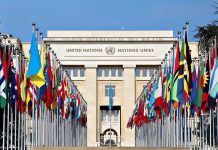
A new interest rate cut by the Federal Reserve raises concerns about its timeliness and effectiveness amidst a government shutdown.
Story Snapshot
- The Federal Reserve announced a second consecutive interest rate cut on October 29, 2025.
- Chair Jerome Powell’s caution about further cuts sparked market volatility.
- The decision was made amid a government shutdown, affecting economic data availability.
- Internal divisions within the Federal Open Market Committee (FOMC) were evident.
Fed’s Response Raises Eyebrows
On October 29, 2025, the Federal Reserve, led by Chair Jerome Powell, announced a 0.25 percentage point reduction in the federal funds rate to a range of 3.75%–4%. This was the second cut in a year, aimed at addressing the weakening U.S. labor market and broader economic slowdown. However, Powell’s statements during the announcement left many questioning the timeliness and effectiveness of the Fed’s response, especially amid a government shutdown that limited access to critical economic data.
The Federal Open Market Committee (FOMC) faced internal divisions over the decision to cut rates. Some members, such as Stephen I. Miran, advocated for a larger 0.5% cut, reflecting deeper concerns about economic risks. Conversely, Jeffrey R. Schmid opposed any change, highlighting a stark contrast in perspectives within the committee. These divisions underscore the challenges faced by Powell, who must balance varying opinions while navigating external pressures and market expectations.
Market Reactions and Economic Implications
The announcement of the rate cut led to immediate market volatility. Stocks fell, and Treasury yields rose as investors reacted to Powell’s cautious tone and the lack of clear guidance on future cuts. The ongoing government shutdown compounds these uncertainties, as it hampers the Fed’s ability to make data-driven decisions. This situation leaves financial markets sensitive to any signals from the Fed, further complicating the economic landscape.
Short-term implications of the rate cut include potential benefits for borrowers through lower interest rates on loans and mortgages. However, these benefits may be delayed by ongoing political and economic uncertainty. In the long-term, the effectiveness of the Fed’s actions in stabilizing the labor market remains uncertain, with risks of undermining its credibility if perceived as inconsistent or insufficient.
Expert Analyses and Future Outlook
Experts remain divided on the Fed’s approach. Some, like Seema Shah from Principal Asset Management, argue that the Fed’s actions are too little, too late to prevent further economic deterioration. Others see the incremental approach as necessary given the current uncertainty. The lack of complete economic data due to the government shutdown adds to the challenge of making informed policy decisions. As the situation evolves, the Fed’s ability to adapt and respond effectively will be critical in shaping economic outcomes.
Looking forward, the Fed’s commitment to maximum employment and a 2% inflation target remains firm. However, with no clear commitment to further rate cuts, the path of monetary policy will largely depend on emerging economic data and developments. Stakeholders across sectors will be closely watching for any signs of policy shifts that could impact their interests.
Sources:
CBS News: Federal Reserve interest rate decision
Federal Reserve: Monetary policy statement
Bankrate: Fed rate cut analysis

















